On The Trail -

What to wear?
by Leah Patton
You've just joined up with a local
trail-riding group, and are getting set for your first
weekend/overnight ride. You ride around your own place in jeans and
boots - but what's proper to wear on a ride? Most clubs don't have
set standards for dress on rides, unless they are sanctioned
Endurance rides, but there are guidelines which everyone should at
least note.
Long pants,
whether jeans, jods, or breeches, are a must. If you are riding Western, jeans are the usual choice. However,
there are many different types of jeans. Straight legs are tighter
fitting and can go inside a boot. Drawbacks - the seam can rub
your inner leg
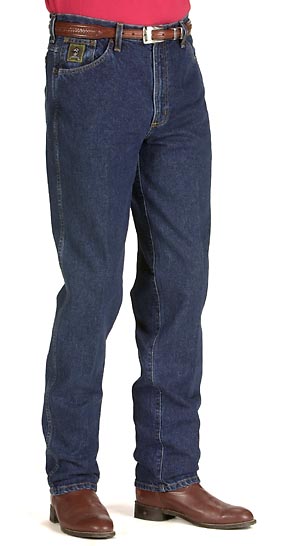 and
ankle if tucked into high boots. Boot cut jeans are designed to go
over the top of a pair of cowboy boots - more on boots themselves
later. Stretch jeans are comfy to some women, but the material is thinner
and doesn't have as much "seat grab" as regular denim jeans. There
are even "karate" jeans that have an special
diamond-shaped inset in the crotch to allow for greater flexibility
in the seat area. This could be a benefit for the smaller rider on a
big mule! and
ankle if tucked into high boots. Boot cut jeans are designed to go
over the top of a pair of cowboy boots - more on boots themselves
later. Stretch jeans are comfy to some women, but the material is thinner
and doesn't have as much "seat grab" as regular denim jeans. There
are even "karate" jeans that have an special
diamond-shaped inset in the crotch to allow for greater flexibility
in the seat area. This could be a benefit for the smaller rider on a
big mule!
A good fit in pants, with enough
leeway to stretch to mount and
dismount, is preferable to pants that are too loose. Loose and baggy
will ride and bunch, and can rub or lie in wrinkles, causing
discomfort in the saddle.
English riders usually go ahead
and wear breeches. The different types of finish in breeches
include knee patches all the way up to full seat breeches. These
leather reinforced areas help cut down on "slide" in the saddle. One
hint - no matter what you decide to ride in, try on those favorite
pants a couple of days before the ride. Don't just dig them out of
the closet and pack them. You might get to your event and find out
they don't quite meet at
the zipper any more!
You may want to wear chaps
over jeans if the weather is cool and the country looks
brushy.
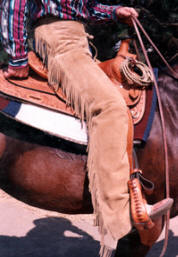  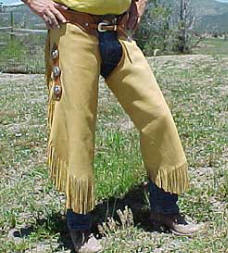 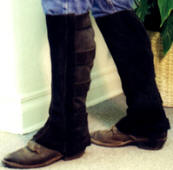
There are also English exercise chaps,
and half-chaps that fit just over the calf and can be used
with short boots.
Always plan on layering your clothes.
You can never quite depend on the weather. Short sleeves or
sleeveless riding shirts are great, but if the temperature drops
suddenly at dark, you'll want to make sure your jacket is in your
saddle bag.
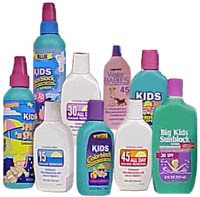 Wear
sun screen! Also, if you go the
bare-armed look, wear sun screen!
A day in the full sun can result in some
mighty tender red
shoulders if not protected. Always use the highest sunblock you can.
Another plus to sleeves is low branches -some cloth over your arms
offers a little protection from scratches. Long-sleeved T-shirts are
popular as casual clothes now, and can always be enhanced with a
photo of your mule for more fun. Big advantage - they are
comfortable in all but the hottest weather, can be wet down in hot
weather for a cooling effect, and the sleeves can be pushed up or
worn down as you like. Pocket tees in both menís and womenís
styles, in a huge variety of colors, are available in most
department stores. Color co-ordinating with your mule or spouse is a
snap! Wear
sun screen! Also, if you go the
bare-armed look, wear sun screen!
A day in the full sun can result in some
mighty tender red
shoulders if not protected. Always use the highest sunblock you can.
Another plus to sleeves is low branches -some cloth over your arms
offers a little protection from scratches. Long-sleeved T-shirts are
popular as casual clothes now, and can always be enhanced with a
photo of your mule for more fun. Big advantage - they are
comfortable in all but the hottest weather, can be wet down in hot
weather for a cooling effect, and the sleeves can be pushed up or
worn down as you like. Pocket tees in both menís and womenís
styles, in a huge variety of colors, are available in most
department stores. Color co-ordinating with your mule or spouse is a
snap!
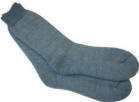
Riding Socks
There are several types of special riding
socks made, as well as those
good old sport
socks. Cushion foot and boot socks are a plus if you think you'll do
some walking. If you are changing to a new type of sock, try them on
with your riding footgear. Some insulated socks (for those fall
rides) may take up too much space in your cowboy boots and pinch
your toes - not a fun thing to find out in the middle of nowhere
with a lame mules.
FOOTWEAR:
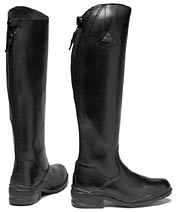 Whatever
style you choose to ride, and whatever footgear you choose to go
with it, anything on your foot should ha Whatever
style you choose to ride, and whatever footgear you choose to go
with it, anything on your foot should ha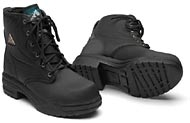 ve
a low heel. Fashion boots with 2" plus heels are a definite out, but
a low heel in on riding boots for a reason. If you have a fall, the
heel on the shoe helps prevent your foot from going all the way
through the stirrup and being hung up. You've always heard you
should never wear tennies around horses or mules. Two
go ve
a low heel. Fashion boots with 2" plus heels are a definite out, but
a low heel in on riding boots for a reason. If you have a fall, the
heel on the shoe helps prevent your foot from going all the way
through the stirrup and being hung up. You've always heard you
should never wear tennies around horses or mules. Two
go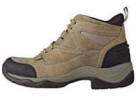 od
reasons - no reinforced protection for the foot should you get
stomped, and no heel for the stirrup-stop. There are new "riding
tennies" (one brand name is Heels Down) that run about the same in
cost (or maybe slightly higher) as some regular tennis shoes. Check
your local tack store for availability - they are worth it. od
reasons - no reinforced protection for the foot should you get
stomped, and no heel for the stirrup-stop. There are new "riding
tennies" (one brand name is Heels Down) that run about the same in
cost (or maybe slightly higher) as some regular tennis shoes. Check
your local tack store for availability - they are worth it.

The style of western boots depends on your taste - but
make sure that they are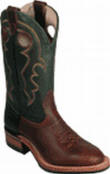 comfortable to walk in. Pinched toes and rubbed heels are no fun
leading back your mule after HE throws a shoe (and you forgot your
Easy Boot). For the same re
comfortable to walk in. Pinched toes and rubbed heels are no fun
leading back your mule after HE throws a shoe (and you forgot your
Easy Boot). For the same re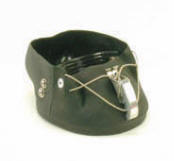 ason,
make sure your boots are already a bit worn and broken in before you ride. Storing your tall boots (english
or western) on boot trees can help prevent them from breaking down
at the ankles. This, in addition to a tall,
narrow stack, can contribute to rubbing at the ankles. English
riders may prefer the riding tennie, or their tall riding boots.
Short field or paddock type boots can also be combined with
half-chaps for more leg protection. ason,
make sure your boots are already a bit worn and broken in before you ride. Storing your tall boots (english
or western) on boot trees can help prevent them from breaking down
at the ankles. This, in addition to a tall,
narrow stack, can contribute to rubbing at the ankles. English
riders may prefer the riding tennie, or their tall riding boots.
Short field or paddock type boots can also be combined with
half-chaps for more leg protection.
UNDERGARMENTS
Can stand the bounce, but can't find the bra? If you
are a big woman, you have a problem, and many of us sympathize.
Those sports bras just don't always do it. Try for a bra with
maximum support, preferably with some shaped around the cup area.
Really big? Try a regular, comfortable bra with a sports exercise
spandex halter top (similar to the sports bras in shape, but cut
longer with less elastic at the bottom) on over it. Then a loose
t-shirt to help keep cool. T-backs on the bras seem to help
somewhat. Whatever your size, make sure the bra is comfortable, and
will not rub you raw on shoulders and underline. Underwires are
probably a no-no, as are scratchy lace and satins that won't absorb
wetness.
You'll sweat - excuse, me, perspire, no matter what. A
bit of baby powder strategically placed when dressing can help. Guys
and gals both - wear comfy drawers! Use cotton - it breathes! High
cut legs will crawl higher the longer you sit - and you know what
that means!!! The longer you can get the leg on drawers, the better.
Biking shorts (in both male and female styles) are great as the legs
come down onto your thigh. There are also special menís and womenís
padded riding underwear. Buy two pairs so you're not stuck with the
crawly type on day two!!!
GLOVES?
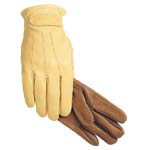 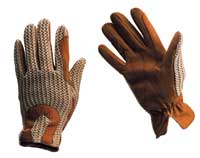 Should
you wear gloves or shouldn't you? Some people do, some don't. Do you
work with your hands a lot? are they tough and worn? You might not
want to. But do you work in a food industry where you can't have
scrapes and cuts on your hands? Or have long fingernails and want
your hands to stay looking nice? Should
you wear gloves or shouldn't you? Some people do, some don't. Do you
work with your hands a lot? are they tough and worn? You might not
want to. But do you work in a food industry where you can't have
scrapes and cuts on your hands? Or have long fingernails and want
your hands to stay looking nice?
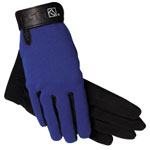 Wear
gloves. Stretch lycra-type gloves for riding are okay if you can
hold the reins without them sliding. combination stretch with
leather is better. All leather are nice, but can get expensive, and
sometimes the dye can sweat off onto your hands. String gloves with textured palms are wonderful for
summer, cool and light. (If the weave is really open, consider a dab
of sunscreen on the back or your hand, or you could end up with an
interesting pattern on your hands! (Sunscreen should be used in
winter, and on overcast days too. The UV rays are still there.) In
winter, gloves should be a must - you need to be able to feel the
reins. Stretch gloves with textured palms, wooly ones with textured
palms, or try the silk glove liners under leather. Try on gloves to
make sure you have plenty of depth in the fingers. Wear
gloves. Stretch lycra-type gloves for riding are okay if you can
hold the reins without them sliding. combination stretch with
leather is better. All leather are nice, but can get expensive, and
sometimes the dye can sweat off onto your hands. String gloves with textured palms are wonderful for
summer, cool and light. (If the weave is really open, consider a dab
of sunscreen on the back or your hand, or you could end up with an
interesting pattern on your hands! (Sunscreen should be used in
winter, and on overcast days too. The UV rays are still there.) In
winter, gloves should be a must - you need to be able to feel the
reins. Stretch gloves with textured palms, wooly ones with textured
palms, or try the silk glove liners under leather. Try on gloves to
make sure you have plenty of depth in the fingers.
HEADGEAR
If seems that a lot of Western riders don't feel the
need to wear a protective helmet.
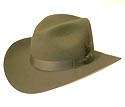 But
there are riding helmets But
there are riding helmets
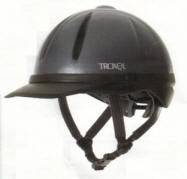 out
there designed for western riders, with a shell shaped like a cowboy
hat to go over it. No offense to anyone who rides without a helmet,
but we sincerely hope it doesn't catch up to you some day. Some of
the worst falls have been from gentle animals. A helmet won't
protect you in every fall, but they can cut down on the out
there designed for western riders, with a shell shaped like a cowboy
hat to go over it. No offense to anyone who rides without a helmet,
but we sincerely hope it doesn't catch up to you some day. Some of
the worst falls have been from gentle animals. A helmet won't
protect you in every fall, but they can cut down on the numbers of injury statistics. There are riding helmets that look
like the bike rider helmets, in addition to the traditional black or
brown velvet hunt cap. So you get hat hair - carry a spritzer bottle
of water (not a bad idea anyway for hot days) and a comb. If
everybody has the same hairstyle, it makes it easier!
numbers of injury statistics. There are riding helmets that look
like the bike rider helmets, in addition to the traditional black or
brown velvet hunt cap. So you get hat hair - carry a spritzer bottle
of water (not a bad idea anyway for hot days) and a comb. If
everybody has the same hairstyle, it makes it easier!
 If
you do use a helmet, make sure it fits with the hairstyle you will
use (ponytails don't always fit and always
fasten the chin safety harness. If
you do use a helmet, make sure it fits with the hairstyle you will
use (ponytails don't always fit and always
fasten the chin safety harness.
 If
you donít use a helmet, If
you donít use a helmet,
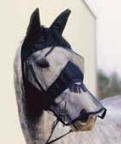 wear
some kind of hat (cowboy hat, baseball/gimme cap) to keep the sun off your head and avoid a
burned scalp! It might be a good idea to call ahead to your riding
event and see if they have rules on helmets, especially for youth
riders. wear
some kind of hat (cowboy hat, baseball/gimme cap) to keep the sun off your head and avoid a
burned scalp! It might be a good idea to call ahead to your riding
event and see if they have rules on helmets, especially for youth
riders.
FINISHING TOUCHES:
You love your jewelry and would never be caught dead without at
least earrings and a necklace. Great - but make them small. Use
earrings that have posts and snug backs, or the kind that have a bar
that loops back up to the hook. You can also put a back on the end of most french-hook earrings to
keep them in place. A 50-mile ride is nowhere to loose your favorite
earrings. If you are wearing a necklace, don't wear long ones that
might catch
You can also put a back on the end of most french-hook earrings to
keep them in place. A 50-mile ride is nowhere to loose your favorite
earrings. If you are wearing a necklace, don't wear long ones that
might catch
 on
the saddle while mounting or dismounting, or one that's going to rub your neck while riding. to sweat. Buy a special watch for riding if needed, and leave
the jointed metal band ones at home. Makeup - go easy or go
without - substitute some water-proof
foundation and/or sunscreen on forehead, nose, and cheeks. Lip balms
rather than lipsticks are a plus - guys might tuck a Chapstick
in their pocket too, and sunscreen can protect the fellow's nose
as well. on
the saddle while mounting or dismounting, or one that's going to rub your neck while riding. to sweat. Buy a special watch for riding if needed, and leave
the jointed metal band ones at home. Makeup - go easy or go
without - substitute some water-proof
foundation and/or sunscreen on forehead, nose, and cheeks. Lip balms
rather than lipsticks are a plus - guys might tuck a Chapstick
in their pocket too, and sunscreen can protect the fellow's nose
as well.
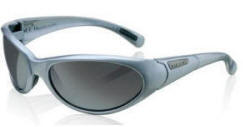 Shades
- you bet. UV lenses are best. Check to see that your shades stay
snug on your face when either looking down or trotting - if not, Shades
- you bet. UV lenses are best. Check to see that your shades stay
snug on your face when either looking down or trotting - if not,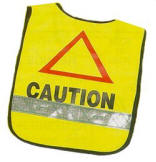 add a band to help hold them on. Sweatbands to keep hair and sweat
out of your eyes - you betcha! Dress for maximum
add a band to help hold them on. Sweatbands to keep hair and sweat
out of your eyes - you betcha! Dress for maximum
PERFORMANCE.
Color coordinate your layers, but the ultimate goal of dressing for
a ride is comfort in the long run. If it rubs, pinches, digs, rides,
or is otherwise uncomfortable, don't wear it! Find an alternate
piece of clothing that does better.
To
help with wear and tear on the seat - your and your saddle's - you
might consider a fleece seat saver. Try it out at home first - some
are more slippery and a few people can't use them at all, as they
loose their grip with their own seat on the saddle. Make sure you
have saddle bags to carry the little extras you need -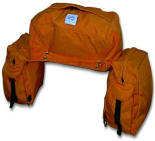 layers, dry socks if you think you might need them, lip balm, small
towel, etc. Get yourself
layers, dry socks if you think you might need them, lip balm, small
towel, etc. Get yourself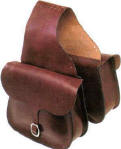 and your mule used to new clothes (this means his saddle too) before
the ride. Don't try new gear out on a long ride - the results might
be painful for both of you. Pack light if you are carrying equipment
on your animal, and always remember to pack an extra set of clothes
beyond the days you'll be riding. You never know when you will get
caught in a sudden downpour on the way back to camp, and realize you
forgot any extra clean clothes!
and your mule used to new clothes (this means his saddle too) before
the ride. Don't try new gear out on a long ride - the results might
be painful for both of you. Pack light if you are carrying equipment
on your animal, and always remember to pack an extra set of clothes
beyond the days you'll be riding. You never know when you will get
caught in a sudden downpour on the way back to camp, and realize you
forgot any extra clean clothes! 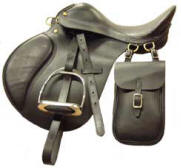

Find a style of outfit you like,
coordinate it to suit, and have fun on the trail! |